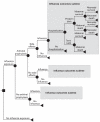Antiviral medications for pregnant women for pandemic and seasonal influenza: an economic computer model
- PMID: 20168096
- PMCID: PMC3388110
- DOI: 10.1097/AOG.0b013e3181bdbfed
Antiviral medications for pregnant women for pandemic and seasonal influenza: an economic computer model
Abstract
Objective: To estimate the economic value of administering antiviral medications to pregnant women who have come in contact with an infectious individual with influenza.
Methods: A computer-simulation model was developed to predict the potential economic effect of antiviral use for postexposure prophylaxis among pregnant women in both seasonal influenza and pandemic influenza scenarios. The model allowed us to examine the effects of varying influenza exposure risk, antiviral efficacy, antiviral cost, and the probability of different influenza outcomes such as hospitalization, preterm delivery, and mortality.
Results: For a variety of pandemic influenza scenarios (attack rate 20% or more, probability of preterm birth for women with influenza 12% or more, mortality for a preterm neonate 2% or more, and probability of influenza-attributable hospitalization 4.8% or more), the postexposure prophylactic use of antiviral medications was strongly cost-effective, with incremental cost-effectiveness ratio values below $50,000 per quality-adjusted life-year. Antiviral prophylaxis became an economically dominant strategy (that is, less costly and more effective) when the influenza attack rate is 20% or more and preterm birth rate is 36% or more, and when attack rate is 30% or more and preterm birth rate is 24% or more. Antiviral prophylaxis was not cost-effective under seasonal influenza conditions.
Conclusion: These findings support the use of antiviral medications for postexposure prophylaxis among pregnant women in a pandemic influenza scenario but not in a seasonal influenza setting.
Figures


Similar articles
-
Economic evaluation of oseltamivir phosphate for postexposure prophylaxis of influenza in long-term care facilities.J Am Geriatr Soc. 2005 Mar;53(3):444-51. doi: 10.1111/j.1532-5415.2005.53162.x. J Am Geriatr Soc. 2005. PMID: 15743287
-
Influenza infection and vaccination in pregnant women.Expert Rev Respir Med. 2010 Jun;4(3):321-8. doi: 10.1586/ers.10.26. Expert Rev Respir Med. 2010. PMID: 20524915 Review.
-
The cost effectiveness of pandemic influenza interventions: a pandemic severity based analysis.PLoS One. 2013 Apr 9;8(4):e61504. doi: 10.1371/journal.pone.0061504. Print 2013. PLoS One. 2013. PMID: 23585906 Free PMC article.
-
Economic value of seasonal and pandemic influenza vaccination during pregnancy.Clin Infect Dis. 2009 Dec 15;49(12):1784-92. doi: 10.1086/649013. Clin Infect Dis. 2009. PMID: 19911967 Free PMC article.
-
Antiviral agents for influenza: a comparison of cost-effectiveness data.Pharmacoeconomics. 2005;23(11):1083-106. doi: 10.2165/00019053-200523110-00003. Pharmacoeconomics. 2005. PMID: 16277546 Review.
Cited by
-
Unremarked or Unperformed? Systematic Review on Reporting of Validation Efforts of Health Economic Decision Models in Seasonal Influenza and Early Breast Cancer.Pharmacoeconomics. 2016 Sep;34(9):833-45. doi: 10.1007/s40273-016-0410-3. Pharmacoeconomics. 2016. PMID: 27129572 Free PMC article.
-
The 2009 H1N1 influenza pandemic: a case study of how modeling can assist all stages of vaccine decision-making.Hum Vaccin. 2011 Jan 1;7(1):115-9. doi: 10.4161/hv.7.1.13740. Epub 2011 Jan 1. Hum Vaccin. 2011. PMID: 21263227 Free PMC article. Review.
-
The cost of an Ebola case.Pathog Glob Health. 2015 Feb;109(1):4-9. doi: 10.1179/2047773214Y.0000000169. Epub 2015 Jan 11. Pathog Glob Health. 2015. PMID: 25578284 Free PMC article.
-
Systematic review of economic evaluations of preparedness strategies and interventions against influenza pandemics.PLoS One. 2012;7(2):e30333. doi: 10.1371/journal.pone.0030333. Epub 2012 Feb 29. PLoS One. 2012. PMID: 22393352 Free PMC article.
-
Maintaining vaccine delivery following the introduction of the rotavirus and pneumococcal vaccines in Thailand.PLoS One. 2011;6(9):e24673. doi: 10.1371/journal.pone.0024673. Epub 2011 Sep 13. PLoS One. 2011. PMID: 21931805 Free PMC article.
References
-
- Cox S, Posner SF, McPheeters M, Jamieson DJ, Kourtis AP, Meikle S. Influenza and pregnant women: hospitalization burden, United States, 1998-2002. J Womens Health (Larchmt) 2006;15:891–3. - PubMed
-
- Cox S, Posner SF, McPheeters M, Jamieson DJ, Kourtis AP, Meikle S. Hospitalizations with respiratory illness among pregnant women during influenza season. Obstet Gynecol. 2006;107:1315–22. - PubMed
-
- Beigi RH. Pandemic influenza and pregnancy: a call for preparedness planning. Obstet Gynecol. 2007;109:1193–6. - PubMed
-
- Greenberg M, Jacobziner H, Pakter J, Weisl BA. Maternal mortality in the epidemic of Asian influenza, New York City, 1957. Am J Obstet Gynecol. 1958;76:897–902. - PubMed
Publication types
MeSH terms
Substances
Grants and funding
LinkOut - more resources
Full Text Sources
Medical

